Matting Techniques for 16x20 Pictures Explained
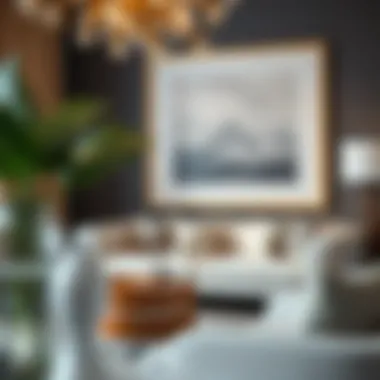
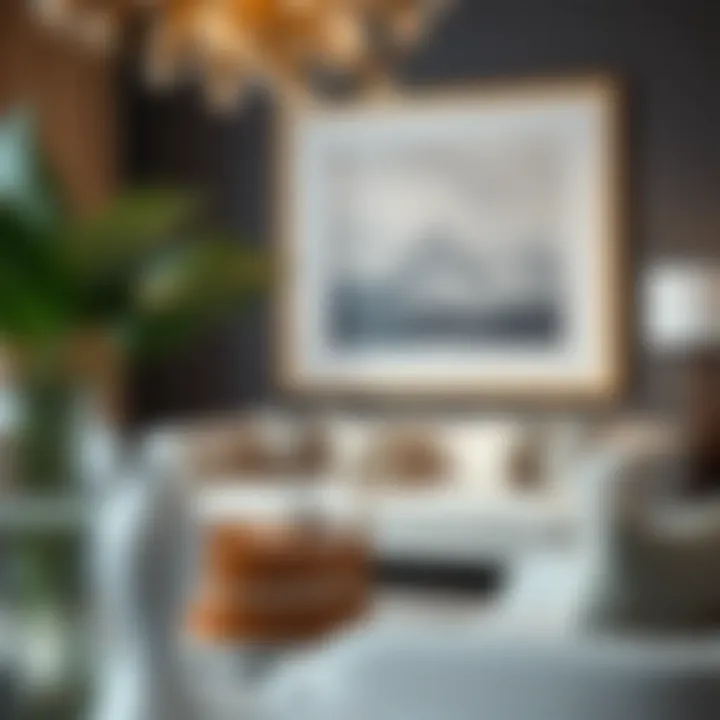
Intro
Matting, often overlooked, plays a vital role in showcasing artwork, particularly for pieces sized 16x20 inches. The aesthetics of your framed art can be significantly enhanced through thoughtful selection of matting materials and techniques. Moreover, understanding the connection between matting and preservation is crucial for homeowners and decor enthusiasts who want their artwork to stand the test of time.
The realm of matting is rich with possibilities. It's not just about adding a border; it's about elevating your piece to a whole new level. With so many styles, colors, and materials available, there’s no shortage of creativity to be found. This guide aims to tackle the essential aspects of matting, moving from foundational choices to advanced design techniques, ensuring that your artwork looks its absolute best. Whether you're a seasoned interior decorator or a DIY enthusiast, equipping yourself with knowledge about matting can illuminate your path toward an effortlessly elegant home environment.
By exploring the different materials available, understanding the common techniques, and analyzing contemporary design trends, you will be ready to enhance your artwork's presentation. This guide goes beyond mere theory; it offers practical advice and insights every step of the way.
Understanding Matting
Matting is not just a decorative border; it serves multiple purposes that enhance the value and aesthetic of any artwork. When dealing with 16x20 pictures, understanding matting is crucial to transform simple photographs or prints into visual masterpieces. Proper matting adds depth, highlights the image, and protects the work from potentially damaging materials. Whether you're a homeowner looking to spruce up your living room or an interior decorator aiming for that perfect finish, grasping the essentials of matting can elevate your presentation.
Definition and Purpose
At its core, matting refers to the material and technique used to frame artwork, photographs, or prints. It creates a space between the image and the frame, allowing for visual breathing room. Remember, a well-chosen mat can make all the difference in the world when it comes to showcasing your art.
- Visual Appeal: By adding a mat, you draw the viewer's eye towards the artwork. It helps the picture stand out rather than merging with the wall or frame.
- Protection: Mats can act as a barrier, preventing the artwork from sticking to the glass, thus avoiding damage from moisture or dirt.
- Customizability: With various materials, colors, and textures, mats can be tailored to individual tastes and styles, allowing you to express your personal aesthetics.
Types of Matting Materials
Selecting the right matting material is key when framing your 16x20 pictures. Each type offers its unique advantages, contributing to the overall impact of your artwork.
Acid-Free Options
Acid-free mats are essential for preserving your artwork, especially for long-term display. Regular paper mats contain acids that can degrade artwork over time, leading to discoloration and deterioration. This quality makes acid-free mats a popular choice among artists and collectors.
- Key Characteristic: Acid-free mats are chemically stable and won't harm your photographs or art over the years.
- Benefit: These mats ensure that your 16x20 prints stay as vibrant and intact as the day you framed them. In a nutshell, using acid-free mats is a best practice for anyone looking to safeguard their cherished pieces.
Colored Mats
Colored mats can add a splash of personality to your framing. They come in various shades and textures, allowing for creativity and customization. The right color can magnify the beauty of your artwork.
- Key Characteristic: They can be chosen to complement or contrast with the artwork, facilitating a cohesive or dramatic presentation.
- Benefit: By carefully selecting colored mats, you can create visual interest that draws viewers in. However, it’s crucial to choose colors that enhance rather than distract from the art.
Textured Mats
Textured mats introduce a tactile element to your framing, adding depth and dimension to your presentation. They come in various finishes, like linen or suede, giving viewers something extra to enjoy visually and physically.
- Key Characteristic: The surface of textured mats can catch light differently, changing how your artwork is perceived depending on the angle.
- Benefit: These mats are particularly effective in guiding the eye toward the artwork, making them a great choice when showcasing striking images. However, selecting a texture that matches the mood or theme of your artwork is vital to avoid dissonance in presentation.
"The right matting can elevate not just the art itself, but the overall environment of the space where it resides."
Measuring for Matting
Measuring for matting might seem like a simple task, yet it holds profound significance in the art of framing. The right measurements not only determine how well your artwork fits into its mat, but they also play a huge role in how it presents visually. Improper measurements can lead to unpleasing results, making the artwork appear cramped or out of proportion. Thus, getting it right ensures that your 16x20 pictures are not only well showcased but also preserved as intended.
Accurate measurements provide a framework to work from, allowing you to choose mats that complement your artwork rather than overshadow it. This process goes hand-in-hand with the aesthetics of the final product, enhancing the depth of colors or creating unique contrasts that draw the eye. We will now delve deeper into accurate measurements and the typical standards that govern matting.
Accurate Measurements
Taking accurate measurements is the cornerstone of successful matting. It's about more than just the dimensions; it’s about maintaining the relationship between the frame, mat, and artwork. When measuring, begin with your artwork itself. Always measure the image size, allowing yourself to note the dimensions precisely. Add a few extra millimeters to account for adjustments in cutting the mat.
Here’s a simple step-by-step approach to ensure your measurements are spot-on:
- Lay your artwork down on a flat surface.
- Use a ruler or measuring tape, ensuring it’s straight for accurate readings.
- Record the height and width of the piece, taking note of any significant features that may affect placement.
- Discuss with an experienced framer or ask for second opinions if something does not feel right. Always trust your instincts.
"A canvas deserves breathing space just as much as it craves structure."
By taking the time to measure accurately, you can sidestep headaches down the road, ensuring that your artwork neither feels clogged nor received wrongly in its new home.
Standard Sizes and Variations
Understanding standard sizes and variations is essential to the matting process. Many people may assume that all pictures are created equal, but there are nuances to each size that can significantly alter the visual outcome. When it comes to matting 16x20 pictures, be mindful of the following:
- Standard Mat Sizes: While 16x20 is a common frame size, the mats used can vary. A typical mat might add one to three inches around the image, showcasing more of the artwork based on composition. For example, a mat measuring 20x24 can offer a desired look without overwhelming the image itself.
- Variations in Depth: Not all mats are made the same; the thickness or depth of the mat can create a three-dimensional effect if you are layering. Standard mats often come in 4-ply or 8-ply thicknesses. This variation can lead to an enriched texture in the final display.
- Cutting Considerations: If the mat is to be cut as part of DIY efforts, understanding standard cutting sizes makes the process smoother. Confident cutting can ensure clean lines that elevate the professional look of the piece.
When selecting the right size, always keep the artwork's aesthetics in mind alongside these standard guidelines. Adjustments may be needed, and being aware of variations can guide you toward making the right choices.
In summary, measuring for matting isn't just about numbers—life and art are in the details. Know what you’re working with, and give your artwork a fighting chance to shine forth in all its glory.
Cutting and Preparing Mats
Cutting and preparing mats for your 16x20 pictures is a crucial step in the presentation of your artwork. It involves more than just cutting a piece of material; it's about enhancing the visual appeal and ensuring the longevity of your pieces. Proper mats can elevate standard prints, creating a more gallery-like feel at home. They also serve a functional purpose, providing support and protection to the artwork.
Preparation is key since mistakes in this stage can lead to wasted materials and less-than-ideal finishes. Understanding the right tools and techniques can make this process smooth and enjoyable.
Tools and Materials Needed
Before diving into the cutting process, it's imperative to gather all necessary tools and materials. This will not only save time but also help prevent unnecessary errors. Here’s a list you might find useful:
- Cutting Mat: A self-healing cutting mat is essential. It provides a durable surface that can withstand repeated cutting without damage.
- Utility Knife or Mat Cutter: A sharp utility knife or a specialized mat cutter ensures clean edges.
- Ruler or Straight Edge: This helps in making precise measurements and cuts. A metal ruler often works best for sturdy support.
- Pencil: You'll need this to mark your cuts on the mat. Make sure to use a pencil that can create fine lines, so they don’t show through when the mat is in place.
- Glass or Acrylic Sheet: Optional, but it provides further protection for your artwork and should be considered if you want extra security against dust and damage.
- Double-Sided Tape: Useful for attaching your artwork to the mat securely without damaging it.
These tools lay the foundation for a successful matting project.
Step-by-Step Cutting Guide
Now that you've got your tools and materials, let’s get down to business with a step-by-step guide on cutting your mats:
- Measure Your Artwork: Begin by measuring the dimensions of your artwork carefully. This will be your starting point for determining the mat size.
- Decide on Mat Width: Choose how much of a border you want around your artwork. A standard mat width is usually between 2 to 4 inches, but depending on your frame and aesthetic preference, this can vary.
- Calculate Matted Dimensions: Add the width to the dimensions of your artwork to get the overall size of the mat. For instance, if your picture is 16x20 inches and you want a 2-inch mat, the final mat size would be 20x24 inches.
- Mark the Mat: Using your pencil, mark the dimensions on the back of the mat. It’s always wise to mark it where it won’t be visible. Make sure to use your straight edge to ensure your lines are straight.
- Set Up Your Tools: Place the mat on the cutting mat, ensuring it's secure. If you are using a mat cutter, align it according to your marked lines.
- Cut the Mat: Start cutting from one corner to the opposite corner, applying consistent pressure to achieve a clean, straight cut. Repeat for all necessary sides.
- Check the Fit: Once the mat is cut, it's time to check if the artwork fits properly. Place your artwork on the mat and see how it looks. Make sure everything aligns to your satisfaction.
- Attach the Artwork: Use the double-sided tape to attach the artwork to the mat securely. Make sure it’s well-centered and straight.
- Final Touches: If you're using a glass or acrylic sheet, place this over your matted artwork for that finishing touch. Make sure it fits snugly within the frame.
By following these steps, cutting and preparing your mats can be an enjoyable process, allowing you to give your 16x20 pictures the attention they deserve. Remember, a well-matted piece can transform not just the artwork itself but the entire room it's displayed in.
“The right mat not only enhances a picture but can make a space feel more complete.”
Ensuring you have properly cut and prepared mats can make all the difference in achieving a finished, polished look to your artworks.
Choosing Colors and Styles
When it comes to matting artwork, the choice of color and style can significantly impact the overall aesthetic of the presentation. The right colors and designs not only complement the artwork but also enhance the visual experience in a more profound way. In a room filled with personal touches, a well-chosen mat can serve as an unsung hero, drawing attention to your masterpiece while seamlessly blending with the surroundings.
Complementing Artwork


Selecting the right mat colors is akin to choosing accessories for an outfit. You want to enhance the main subject without overshadowing it. It’s essential to consider the hues and themes present in the artwork itself. For example, if your picture showcases vibrant florals, a mat that picks out one of those colors can create a cohesive look. On the other hand, a contrasting mat can help elevate the artwork, giving it a more striking presence. In short, the mat should complement but not compete with the art.
Popular Color Schemes
Choosing a color scheme can feel overwhelming, especially with the myriad of options available. Here are some popular choices:
Monochromatic
Monochromatic schemes use variations of a single color – think shades and tints. This approach offers an elegant, unified look that can accentuate the details in your art. One key characteristic of monotone colors is their soothing quality, making them a popular choice for serene environments. The unique feature of monochromatic mats is their ability to create a cohesive feel, tying together different pieces in a gallery wall or a single artwork with multiple shades. Although they can sometimes feel too restrained, with the right artwork, they can render a sophisticated look that speaks of thoughtful design.
Contrasting Colors
Contrasting colors include pairs that lie opposite each other on the color wheel, bringing an energetic vibe to any display. A mat in a contrasting hue can really make your artwork pop — think about a deep blue mat surrounding a vibrant orange sunset. This key aspect captures attention and can invigorate a dull corner of a room. The unique feature of contrasting mats is that they offer a bold statement, allowing for creativity in your presentation. However, one disadvantage might be that such pairings require careful balance to avoid overwhelming the viewer, requiring some artful consideration of tone and intensity.
Neutral Palettes
Neutral palettes encompass shades like whites, blacks, grays, and browns. These colors are favored for their versatility and timeless elegance. One key characteristic of neutral mats is their ability to serve as a quiet frame for bold artwork while ensuring that their presence feels intentional. The unique advantage is that neutrals can blend seamlessly into almost any decor style, from classic to contemporary. However, their downside could be that they sometimes lack the visual punch that a bolder color can bring, making careful selection essential to ensure it resonates well with the artwork's message.
In the end, choosing colors and styles calls for deliberation, guiding both the emotions evoked by the art and the harmonious balance of the entire room’s design. As you navigate this creative endeavor, remember that the aim is to craft a space that feels distinctly yours while honoring the artwork it showcases.
Professional vs. DIY Matting
Choosing between professional services and a DIY approach to matting is a significant decision that can affect both the outcome and your budget. Each option comes with its own set of advantages and challenges. While you may lean towards doing it yourself to save a few bucks, enlisting a professional can sometimes offer benefits that outweigh the cost.
Advantages of Professional Services
When it comes to having your 16x20 pictures matted, professional services often have the upper hand. Here are several reasons:
- Expertise: Professionals have years of experience and training in matting techniques. They know the best materials to use and how to handle various artwork without causing damage.
- Quality Results: A professional-grade matting job typically boasts precise cuts and clean lines. That means less risk of uneven edges or warped materials.
- Time-Efficient: For those juggling a busy schedule, professional services save time. You can rely on them to take care of the details, allowing you to focus on other tasks.
- Variety of Options: Professionals often have access to a broader selection of materials and styles. This can be an advantage when looking to create something truly unique for your artwork.
- Preservation Techniques: Experts understand the importance of using acid-free materials and proper mounting methods to ensure the longevity of your art.
Considering these benefits, it’s clear why many opt for professional matting when the stakes are high.
Benefits of DIY Approach
While professional services come with distinct benefits, the DIY approach shouldn’t be overlooked. Here are some compelling reasons why certain homeowners and enthusiasts might prefer to roll up their sleeves:
- Cost Savings: One of the foremost reasons for DIY matting is, of course, cost. Purchasing materials and doing the work yourself can save a considerable amount of money compared to hiring professionals.
- Personal Touch: A DIY project allows you to customize every aspect based on your style and preferences. This personal touch can make your artwork feel more special and integrated into your space.
- Creative Freedom: Taking on a DIY project means you can experiment with different techniques and styles without being constrained by a professional’s recommendations.
- Learning Experience: The process of matting your own pictures can be educational. You’ll gain valuable skills and insights about art presentation—a plus if you often frame art.
- Arranged At Your Pace: With a DIY approach, you control every step, which means you can take your time to ensure you're satisfied with the results.
Ultimately, whether to choose professional services or pursue a DIY project comes down to personal priorities, budgets, and the importance of precision versus creativity. Many find that striking a balance between both methods can yield the best results.
Common Mistakes to Avoid
When embarking on the journey of matting your 16x20 pictures, recognizing common pitfalls can save you both time and frustration. Mistakes can potentially diminish the visual impact of your artwork and affect its longevity. In this section, we will illuminate the essential mistakes to sidestep, ensuring your art looks its best and is preserved properly.
Choosing Inappropriate Materials
Selecting the right materials is pivotal for successful matting. Using improper materials can lead to various issues, including discoloration and damage to the artwork itself. For instance, mats that are not acid-free can release harmful chemicals over time, which might cause your picture to fade or deteriorate.
When considering your options, always look for materials that are specifically labeled as archival. This helps in ensuring the durability of your matting. Not only does this increase the aesthetic appeal, but it also promotes preservation. Additionally, the choice of color is equally essential; a poorly chosen mat color can clash with your artwork, rendering it less captivating.
- Use acid-free materials to prevent deterioration.
- Opt for colors that complement, rather than overpower, the artwork.
- Textured mats can add depth but should harmonize with the art instead of distracting from it.
Incorrect Measurements
Nothing can ruin an art presentation quite like incorrect measurements. The beauty of a matted picture lies in its precision, and a miscalculated measurement can lead to a disastrous fit. Whether your piece is slightly too snug or swimming in excess space, both outcomes can detract from the overall impression.
To tackle this issue, it's crucial to measure twice, cut once. Always ensure that your mat is at least .5 inches larger than the artwork on all sides, giving it a balanced look.
Additionally, having a mate template can be beneficial. By utilizing a template, you can avoid the headache of cutting too short or too long. So go ahead and take that extra five minutes to double-check your dimensions—your artwork deserves it.
Neglecting Preservation Techniques
Preservation should be at the forefront of any matting endeavour. Many folks are so excited about the visual impact of their matting that they overlook essential preservation techniques. Sadly, this often leads to regrettable consequences down the line.
One common oversight is failing to use UV-protective glass. Without it, sun exposure can fade colors and deteriorate the artwork over time. Also, many forget about spacing when mounting—slam-dunking straight onto the mat can lead to damage.
To ensure your art remains vibrant, consider the following tips:
- Use UV-filtering glass or acrylic for protection against sunlight.
- Avoid direct contact between the artwork and mounting materials.
- Maintain an appropriate humidity level to prevent mold and mildew.
"Proper preservation ensures that your investment in art remains valuable and visually stunning for generations."
Mounting Techniques
Understanding mounting techniques is essential when it comes to showcasing your 16x20 pictures effectively. The right approach can enhance the visual appeal of your artwork while providing stability and protection. Various methods exist, each with unique advantages and considerations that cater to different styles and needs.
Types of Mounting
Choosing the appropriate method for mounting your artwork directly impacts its presentation. Here’s a closer look at three primary techniques:
Straight Mounting
Straight mounting is perhaps the most straightforward method. In this approach, the artwork is affixed directly to the mat or backing board, usually with an adhesive or tape. One standout feature of straight mounting is its simplicity. It’s a go-to choice for many artists and homeowners who appreciate a clean presentation.
Benefits of straight mounting include:
- Ease of Use: This method is incredibly user-friendly, making it accessible even for those with minimal experience.
- Flat Appearance: The artwork sits flush against the mat, eliminating any unwanted shadows or gaps.
However, there's a caveat:
- Limited Depth: As the artwork is attached directly, you might lose some depth that other mounting techniques could create. This may not appeal if you're aiming for a more dynamic display.
Floating Mounting
Floating mounting, on the other hand, creates a unique visual effect where the artwork appears to hover within the matting. This technique uses spacers to lift the artwork, leaving a gap between it and the mat. The key attraction here is the artistic presentation it offers.
Key characteristics of floating mounting include:
- Dynamic Visuals: The hovering effect draws the eye, making this method a favorite among contemporary decorators.
- Emphasis on Art: It gives the artwork more presence by allowing light to interact with it.
But there are some considerations:
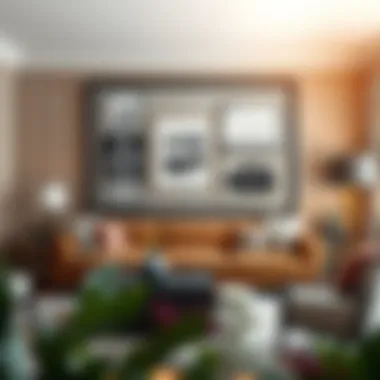
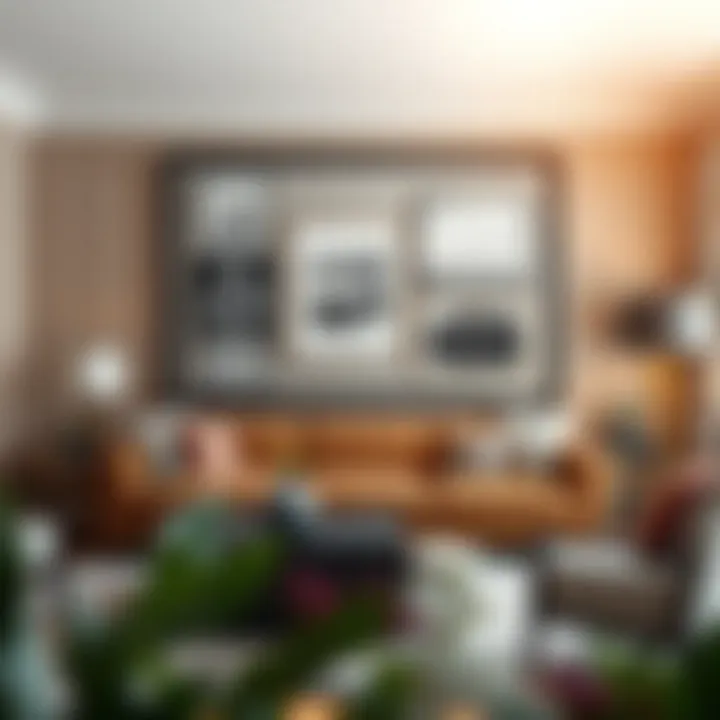
- Complex Setup: Floating mounting demands precision in execution, which can be challenging without prior experience.
Corner Mounting
Corner mounting is a technique often overlooked, yet it provides a unique way to frame your artwork. In this method, the artwork is secured at the corners, allowing the rest of the piece to remain unencumbered. This not only affords certain design flexibility but also enhances the overall aesthetic.
The main traits of corner mounting include:
- Minimalist Look: It gives a clean, uncluttered profile, allowing the artwork to be the hero.
- Easy Adjustment: If needed, it’s much simpler to change out pieces without damaging the mat or backing.
On the downside:
- Stability Concerns: Since only the corners are adhered, this method might not be suitable for heavier pieces or delicate artwork.
Best Practices for Secure Mounting
To ensure that your art remains secure regardless of the mounting type you choose, follow these best practices:
- Use Acid-Free Materials: This helps in preventing deterioration over time.
- Double-Check Measurements: Accurate sizing lays the groundwork for a professional finish.
- Adhesives Matter: Opt for archival-quality adhesives, particularly if you care about preserving your piece long-term.
"The technique you choose to mount your artwork can significantly influence not just its safety but also how it conveys your artistic vision."
In sum, selecting the right mounting technique requires a balance between aesthetics and practicality. Each method brings its own charm and considerations, allowing the 16x20 picture not just to be framed, but to live and breathe within a gallery of its own.
Framing Considerations
When it comes to presenting your 16x20 pictures, the frame acts as the finishing touch that ties together the overall aesthetic and ensures longevity. Choosing the right frame is more than just about looks; it's a crucial aspect of both preservation and style. With countless options available, understanding the factors that influence your choice can lead to a more polished presentation of your artwork.
Selecting the Right Frame
Finding the perfect frame means considering several elements:
- Material: Opt for wood, metal, or synthetic materials based on the desired feel. Wood lends warmth and elegance, while metal can provide a sleek, contemporary look.
- Color: This can impact not just your artwork, but also the room's ambiance. Neutral colors may enhance vivid art, while a bold frame can be a statement piece on its own.
- Style: Don’t overlook how your frame’s style interacts with the picture itself. The frame should complement, not distract. An understanding of design principles will help you strike that balance.
Frame Styles and Trends
Different styles of frames can evoke varied emotions and set distinct tones for your artwork. Below are some prominent styles:
Classic
Classic frames often feature ornate designs, such as intricate carvings and gilded finishes. Their key characteristic lies in their traditional appearance, which works wonderfully in formal settings or period homes. The unique feature of a classic frame is that it embodies timeless elegance, but it may not suit modern or minimalist decor. This can make classic frames less versatile for all types of artwork, especially contemporary pieces.
Modern
Modern frames prioritize simplicity with clean lines and minimal embellishments. These frames often come in neutral shades like black, white, or silver, making them an ideal fit for contemporary art. Their benefit lies in their understated nature, allowing the artwork to take center stage. However, their lack of ornamentation can sometimes feel too stark or impersonal for those who prefer a more decorative approach.
Rustic
Rustic frames are characterized by their rugged textures, often made from reclaimed wood or treated to look aged. This style lends an organic, earthy feel to the artwork, making it fitting for cozy, informal spaces such as cabins or country homes. A key advantage of rustic frames is their ability to bring warmth and character, but they might clash with sleek, modern designs, thus requiring careful selection to maintain harmony in your decor.
Choosing a frame is not just about the aesthetics; it's about marrying the artwork to its surroundings. Making the right choice ultimately reflects your personality and enhances the experience of viewing your art.
Caring for Matted Artwork
Caring for matted artwork is not just about keeping things tidy; it's about preserving the integrity and beauty of the pieces you love. Matted art can be sensitive to various factors like dust, humidity, and light exposure. Proper care ensures that your artwork retains its original charm over time. Whether you are a homeowner looking to enhance your living space, an interior decorator, or a DIY enthusiast, understanding the ways to care for your matted pictures can prolong their life and maintain their appeal.
Cleaning Tips
For keeping your matted artwork in pristine condition, regular cleaning is essential. Here are some key points to consider:
- Dust Regularly: Use a soft, lint-free cloth to gently wipe your matted artwork. This helps to prevent dust from accumulating, which can cause discoloration or damage.
- Avoid Moisture: If your mats are made of paper, too much moisture can lead to warping. Keep cleaning solutions away from your artwork, and if needed, lightly dampen your cloth without any harsh chemicals.
- Use a Vacuum with Caution: If there’s a heavy buildup of dust, consider using a vacuum with a soft brush attachment. Make sure to do this from a safe distance to avoid any accidental damage.
- Check for Smudges: If you notice fingerprints or other marks on the glass, use a glass cleaner on a cloth, but only after ensuring it is safe for your mat material. Avoid spraying directly onto the artwork.
Handling and Storage
Proper handling and storage are crucial to maintain the longevity of your matted pieces. Here’s a breakdown of helpful advice:
- Always Wash Your Hands: Before touching your artwork, wash your hands to remove oils and dirt that could transfer to the mat or photo. Even a tiny smudge can be hard to clean off later.
- Use Gloves: If possible, wear cotton gloves while handling to prevent skin oils from coming into contact with the mat or picture. This is especially important for delicate materials.
- Store Flat: If you need to store your matted art, lay them flat in a protective case or on a clean surface. Avoid stacking too many pieces atop each other to prevent pressure damage.
- Climate Control: Find a storage location that is cool and dry. Avoid attics or basements where temperature and moisture levels vary significantly, as these conditions can harm your artwork over time.
Ensuring the right care for your matted artwork can make all the difference between a cherished piece that remains a joy to view and one that has suffered due to neglect.
By keeping these care tips in mind, you can maintain the aesthetic and physical qualities of your matted artwork, ensuring that it continues to enrich your environment. In a world where preservation is key, a little effort goes a long way.
Artistic Enhancements
When it comes to matting your 16x20 pictures, artistic enhancements play a pivotal role in elevating the visual appeal and impact of your framed art. This section delves into the significance of using decorative elements and layering techniques, focusing on how these choices can transform simplicity into sophistication.
Using Decorative Mats
Decorative mats serve not only as a functional element but also as a canvas for creativity. They can be eye-catching additions that either complement or contrast your artwork. Choosing a mat that carries intricate designs, patterns, or colors can breathe life into a piece, drawing the viewer's eye immediately.
Benefits of using decorative mats include:
- Aesthetic Appeal: Decorative mats can enhance the overall look of your artwork, making it more intriguing.
- Framing Context: They help in framing the context of the piece—think of a vintage photograph in a distressed-looking mat, for instance. The mat becomes a character in the story.
- Depth Creation: A well-selected decorative mat adds depth, making the overall presentation more three-dimensional.
However, while it's tempting to choose flashy designs, moderation is key. Often, less is more. A busy mat can compete with, rather than complement, the artwork itself.
Layering Techniques
Layering is another vital technique to consider in the realm of matting. This method involves placing multiple layers of mats, each with their own color or texture, to create a sense of depth and complexity.
Here is how to effectively apply layering techniques:
- Choose Base and Accent Mats: Your base mat should typically be neutral, allowing the artwork to shine. Accent mats can bring in colors that play off the piece.
- Vary the Widths: Using different widths for the layers adds interest. A wider base mat can create a grounding effect, while a narrower accent layer energizes the visual flow.
- Consider Textures: Mixing textures is where the magic happens. For instance, a smooth base mat juxtaposed with a textured accent can create a striking visual effect.
"Layering adds complexity to your artwork presentation, encouraging viewers to look deeper."
Effective layering requires a thoughtful approach—ensure that the color and texture combinations enhance, rather than clash. Seek out inspiration through platforms like Pinterest or Instagram, where decor enthusiasts share their unique takes on layering mats to enrich the visual story of their art.
By incorporating these artistic enhancements into your matting strategy, you not only elevate the frame but also enrich the viewer's experience, ensuring your artwork is showcased in the best light possible.
Cost Considerations
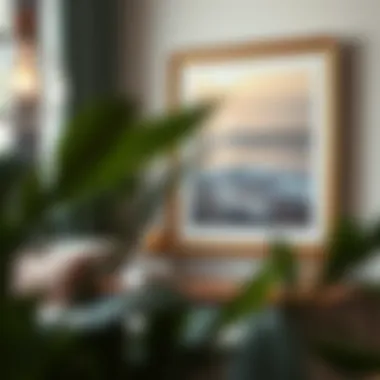
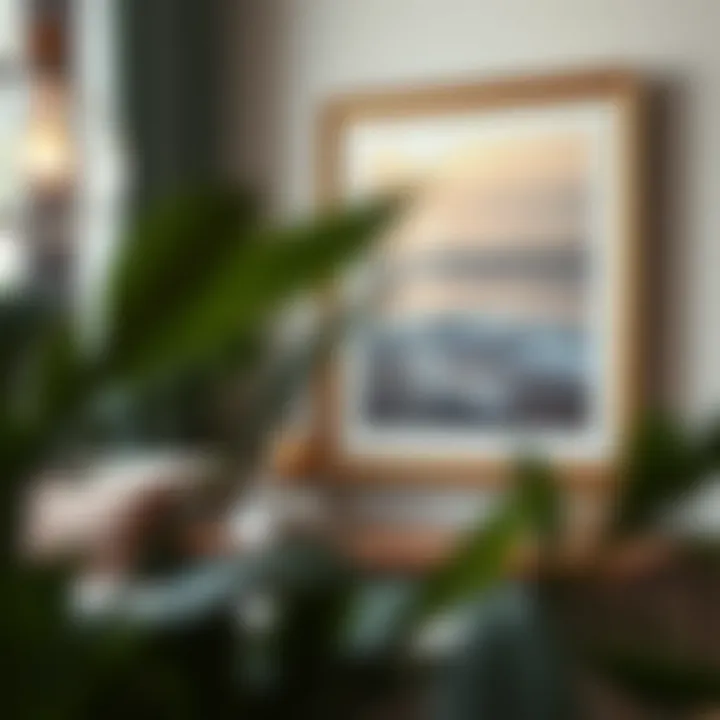
When embarking on the matting journey for your cherished 16x20 pictures, the element of cost plays a crucial role. Understanding how to balance aesthetics and budget can be the difference between an art piece that shines and one that feels lackluster. Not only do costs affect your immediate expenses, but they also impact your long-term satisfaction with the artwork presentation.
Getting the right matting doesn't just involve picking something that looks good; it’s about making smart financial decisions that align with your artistic vision. From the thickness of the mats to the type of materials you choose, every decision carries a price tag. Here we will delve into several layers of cost considerations, providing clarity on how to approach budgeting and comparing professional services with DIY options.
Budgeting for Matting
To start, budgeting for matting requires a clear understanding of your financial parameters. Take a moment to list out the costs related to matting:
- Material Costs: The type of mat board can significantly influence your budget. Acid-free boards are typically more costly but essential for preserving artwork.
- Tools and Supplies: If you decide to go DIY, you'll need the proper cutting tools, adhesives, and possibly even protective gear. These need to be factored into your total cost and weigh against hiring a professional.
- Frame Expenses: Don’t forget that matting usually goes hand in hand with a frame. The quality and design of the frame can also add up.
Creating a list can help in identifying which area might allow for adjustments. For example, you might choose a less expensive mat to allow for a more intricate frame or vice versa.
Comparing Professional vs. DIY Costs
Deciding between professional matting services and a do-it-yourself approach can challenge even the most seasoned art enthusiasts. Here are some points to consider:
Professional Services
- Pros:
- Cons:
- Expert quality that guarantees precision
- Time-saving; no need to learn the intricacies of matting yourself
- Can be pricey, often upwards of $50-$200 depending on complexity and quality.
- Limited control over materials and design.
DIY Approach
- Pros:
- Cons:
- Potentially lower costs, especially if you already have essential tools.
- Full creative control over design and materials.
- Requires time investment to learn and execute matting techniques effectively.
- Risk of errors and potential waste of materials, which could offset lower costs.
The choice ultimately hinges on your confidence in creating a beautiful presentation and your budgetary constraints. While DIY can save a penny, it might cost you peace of mind if things don’t go as planned.
"In the end, whether you go professional or DIY, ensuring that your artwork is properly matted can enhance both its aesthetic value and its longevity, making it crucial to weigh your options carefully."
Whether you’re an ardent DIYer or someone who prefers to hand off the task to the experts, understanding these costs will give you the upper hand in making an informed decision about your artwork's display.
Trends in Matting
Staying ahead of the curve in home decor means keeping your finger on the pulse of trends in matting. This realm, often overlooked, plays a crucial role in how art is presented and preserved. Whether you're an interior decorator looking to elevate spaces or a homeowner wanting your framed art to speak volumes, understanding current matting trends can elevate your aesthetic game. Incorporating trendy matting can profoundly affect the overall vibe of a room, making it not only a showpiece but also a reflection of personal style.
Benefits of Staying Trendy
Familiarizing yourself with current trends in matting offers numerous advantages:
- Enhanced Visual Impact: Trends can serve as inspiration, helping to create more visually appealing spaces.
- Increased Longevity: With many modern materials designed for durability, using current trends often enhances the preservation aspect of your artwork.
- Personal Expression: Following trends allows you to express your personality and style through art presentation.
Adapting to these trends is not just about aesthetics; it's about the marriage of form and function, where each mat complements the artwork while providing protection. The right choice can transform a simple image into a stunning focal point.
Current Aesthetic Trends
When it comes to matting, the design landscape is always shifting, and lately, some standout trends have emerged. These trends often fuse creativity and innovation, breathing new life into how we frame our cherished memories. Here are some of the most noteworthy aesthetic trends:
- Bold Colors: Forget about the traditional muted palettes. Right now, bold color choices are in vogue. Electric blues, fiery reds, and sunny yellows can make a statement, pulling focus to the artwork in a fresh way.
- Seasonal Themes: More homeowners are leaning into seasonal matting that reflects changes in decor throughout the year. Soft pastels for spring and warm earth tones in autumn—that’s how it’s done!
- Layering Textures: Mixing different textures is becoming increasingly popular. High-gloss mats paired with a rougher, textured outer mat provides a rich tactile experience that catches the eye.
- Minimalist Designs: With all the noise in modern life, many seek the calm of minimalist aesthetics. Simple, clean lines that serve as a mere backdrop to the art are becoming quite prevalent.
The fusion of traditional elements with new, innovative ideas ensures that today's matting choices remain not just functional, but an art form in their own right.
Influence of Minimalism on Matting
Minimalism has taken the design world by storm, and matting is no exception. This approach emphasizes simplicity, stripping away the excess to focus on the essence of the artwork itself.
- Sleek Profiles: Gone are the days of heavy, ornate frames. Minimalist mats typically sport sleek profiles that enhance clean lines, creating a focused environment for the art.
- Soft Colors: When it comes to color, subtle shades dominate. Soft whites, greys, and blacks serve as the perfect backdrop for enhancing the artwork without overpowering it.
- Open Spaces: In minimalist decor, less is more—even with matting. Many designers are opting for larger mats, allowing empty spaces to breathe, which instills a sense of calm and spaciousness.
- Functional Elegance: The beauty of minimalist matting lies in its utility. It often integrates preservation techniques seamlessly without being showy or ostentatious.
In a world where clutter often reigns supreme, minimalist matting offers a breath of fresh air, aligning with a broader aesthetic philosophy that seeks to celebrate simplicity, authenticity, and emotional resonance in art. Embracing this trend means creating a serene space that speaks volumes through restraint rather than excess.
"In order to be irreplaceable, one must always be different." - Coco Chanel
In the realm of matting, this rings particularly true. Adopting trends like minimalism not only sets a visual standard but also encourages a thoughtful consideration of how art interacts with its environment.
Examples and Inspirations
Selecting the right matting can significantly transform how art is perceived. This section highlights the importance of gathering examples and inspirations when choosing materials, colors, and styles. Understanding successful configurations can guide homeowners and decorators alike in making decisions that resonate with both the artwork and the environment in which it is displayed. By analyzing various case studies and user-submitted works, you gain insight into practical applications and creative approaches to matting.
Case Studies of Successful Matting
When it comes to matting for 16x20 pictures, there's beauty in the details. A well-chosen mat not only enhances the artwork but also brings the overall aesthetic of a room together. For instance, let’s consider a case study of a contemporary art piece—consider a vibrant abstract painting displayed in a minimalist setting. Here, a sleek, black mat completed the look, making the colors pop against a neutral background.
Another compelling example involves a vintage photograph that was brilliantly framed. In this case, using a gold-toned mat added warmth and richness, creating a contrast that breathed life into the black-and-white image. The choice of matting heightens the viewer’s experience and elevates the perception and value of the piece.
"Mats are not just to hold a picture; they are a border that can create a new frame of reference for the viewer."
Taking your own case study further, think about textures. A soft fabric mat around a serene landscape photo can invoke a feeling of tranquility, inviting viewers to stay awhile longer. The materials chosen not only protect but also enrich the artistic storytelling.
User-Submitted Works
Crowdsourcing inspiration from others' experiences can lead to a treasure trove of ideas. Many users have shared their successes and techniques online, offering a well of creativity to tap into. For instance, one user showcased their approach by layering multiple mats of varying sizes and colors, creating depth that captivates the eye. They juxtaposed a cream mat with a maroon under-mat, which helped frame a striking portrait of a beloved pet. This thoughtful pairing served both an aesthetic function and a sentimental one.
Users on platforms like Reddit and art forums often post images of their work, documenting the matting process from start to finish. This can be an eye-opener; seeing real-life implementations helps demystify the challenges of matting. Comments and discussions around these submissions often highlight the benefits of experimentation and personal style, emphasizing how the right mat can turn a simple piece into a showstopper.
In short, examples and inspirations often come from an amalgamation of professional advice, community experiences, and personal intuition. The exploration of these sources serves to inspire and assists each individual in crafting a matting solution that speaks to their style and complements their artwork.
Finale
When it comes to the presentation of your cherished 16x20 pictures, matting serves not just as a decorative element; it is a crucial layer of protection and visual appeal. This guide has explored the multitude of aspects surrounding matting, emphasizing its importance in enhancing both aesthetics and preservation of artworks. By selecting suitable materials and employing appropriate techniques, you can extend the lifespan of your artwork while ensuring it looks fantastic on display.
Matting influences the overall impact your artwork has in any setting. A well-chosen mat can provide a balanced background, allowing the picture itself to shine. Furthermore, understanding the various types of mats available, from acid-free varieties to textured options, equips you with the knowledge to make informed decisions. This is especially significant for homeowners, interior decorators, and DIY enthusiasts, who aim to create a curated and harmonious space.
Additionally, as trends in matting evolve, being aware of popular color schemes and styles can help keep your decor fresh and reflective of personal taste. Whether opting for a minimalist look or something more dramatic, the right mat can effectively tie the whole presentation together. Overall, consider how each element discussed impacts your artwork's longevity and appeal. This understanding elevates your approach, ensuring thoughtful selections are made that enhance the visual storytelling of your photography and art.
"The right matting not only enhances beauty but also protects the memory encapsulated within the frame."
Recap of Key Points
- Definition and Purpose: Matting serves as both a protective barrier and an aesthetic enhancer for artwork.
- Types of Materials: Importance of using acid-free materials to prevent damage, along with options like colored and textured mats to enhance visual interest.
- Color and Style: Complementing your artwork is crucial; understand which schemes resonate and elevate the overall presentation.
- Care and Maintenance: Regular upkeep and appropriate handling protect the artwork from environmental factors.
Final Thoughts on Matting for 16x20 Pictures
In summation, matting is more than just an afterthought; it's a foundational aspect of showcasing art. For homeowners, designers, and enthusiasts, understanding the nuances of matting allows for a richer and more personalized approach to displaying 16x20 pictures. The interplay between mat and art creates a visual dialogue that speaks to both the artist's intention and the viewer's emotion. Investing time into learning about matting—its trends, techniques, and best practices—ultimately reflects a deep appreciation for art and its preservation. This guide serves as a resource for making those choices; now it's time to apply that knowledge, create stunning displays, and protect the moments captured in your favorite pieces.



